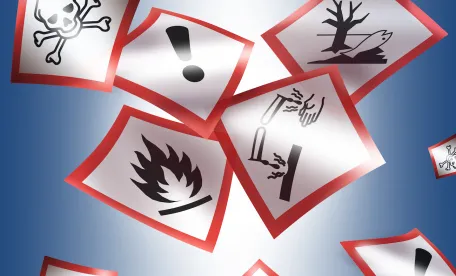As Occupational Safety and Health Administration (“OSHA”) evaluates amending the Hazard Communication Standard (“HCS”), 29 CFR 1910.1200, both industry and work safety groups continue to warn that the proposed changes go too far. Although couched as simple changes that will bring the standard in alignment with international standards for management of hazardous materials, the agency’s proposed rulemaking has broad implications, particularly for materials that may not have been classified as hazardous in the past.
First published in 1983, the HCS required manufacturers to not only evaluate the hazards associated with the chemicals they created, stored and distributed, but also to communicate those hazards on labels and material safety data sheets (“MSDS”). In 2012, OSHA overhauled the HCS to incorporate the United Nations’ Globally Harmonized System of Classification and Labelling of Chemicals (“GHS”). In doing so, OSHA modified the system for classifying hazardous materials and replaced the MSDS with Safety Data Sheets (SDS), which conformed with the more user-friendly and specified GHS format. These changes were aimed at ensuring effective communication to employees on chemical hazards and employee comprehension of certain hazards.
The proposed rulemaking seeks to modify conditions for labeling and SDS hazard warning language by updating the HCS classification and labelling to the more recent versions of GHS (the GHS is on Revision 8, but OSHA’s proposal would only align the HCS to with Revision 7 of the GHS and select provisions of Revision 8). OSHA’s rulemaking also seeks to resolve issues that arose during implementation of the 2012 HCS, such as considerations for small packages, potentially conflicting warning language and classifications for aerosols. By aligning with the more recent version of the GHS, OSHA is also attempting to align the HCS with international guidance from the United Nations, other U.S. agencies, like the U.S. Environmental Protection Agency and international trade partners. The proposed modifications to the standard also include revised criteria for classification of certain health and physical hazards, which in turn require labeling and SDS changes, as well as detailed considerations for label management, new labeling provisions for small containers, technical amendments related to the contents of SDS and revised definitions.
While OSHA intended these changes to increase worker protections and reduce the incidence of chemical-related occupational illnesses and injuries, some stakeholders have expressed concerns over the impact of the changes on worker safety. In particular, the California Division of Industrial Relations Division of Occupational Safety and Health (“Cal/OSHA”) and allied work-safety groups have expressed a fear the proposed amendments will limit protections for workers. Cal/OSHA’s May 18 comment letter notes that the proposal will reduce the amount and quality of chemical hazard information available to workers because it discounts chemical evaluations from EPA and other regulatory agencies and instead relies solely upon the judgment of the producers to classify their products’ hazards.
On the other hand, industry groups are concerned the proposed changes would place an impossible regulatory burden on manufacturers and importers to compile substantial data on hazards posed by their products, with specific consideration for all possible exposures that could occur beyond known downstream uses. Manufacturers and suppliers have limited visibility to downstream uses once a product leaves their control. But they would now be required to anticipate and describe the hazards the product might attain if a downstream user were to change its physical characteristics, resulting in different physical forms, reactions or reactants, or unexpected based on new or novel uses. This obligation may create the greatest difficulty for manufacturers and importers given the new, creative uses for chemicals that just a few years ago were considered inconceivable.
Still further, others assert OSHA’s proposed changes exceed the scope of the HCS altogether and will impermissibly serve as a vehicle for OSHA to gather chemical data that can then be exchanged with EPA through the agencies’ collaboration on hazardous materials. OSHA, in particular, can obtain confidential business information on a specific chemical product in collaboration with EPA under the agencies’ memorandum of understanding and interagency working groups, which can then be used to help the EPA craft future Toxic Substances Control Act (“TSCA”) chemical evaluations and added regulatory obligations.
Employers who do not manufacturer or supply products also have requirements under the proposed changes. Covered employers would, in fact, need to review their product inventories, ensure proper product classification, and update their written programs, SDSs, and training materials. Employers also may need to modify their labeling procedures and methods of communicating chemical hazards. Once these changes are complete, employers will have to train to affected managers, supervisors and employees.
A virtual public hearing on the proposed revisions begins September 21, 2021, at 10 a.m., EDT. Individuals interested in appearing must submit a notice of intent to appear by June 18, 2021 for Docket No. OSHA-2019-0001 electronically at http://www.regulations.gov.




 />i
/>i

